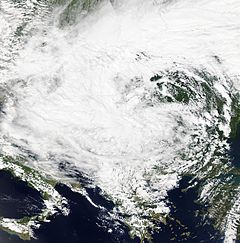2014 Southeast Europe floods

The Yvette storm in Southeast Europe and Balkans, 15 May 2014
|
|
| Date | 13 May 2014 – 27 May 2014 |
|---|---|
| Location |
|
| Deaths |
At least 86 |
| Property damage | More than one billion euros |
At least 86
57 in Serbia
24 in Bosnia and Herzegovina
2 in Croatia
2 in Romania
1 in Slovakia
Between 13 and 18 May 2014 a low-pressure cyclone designated Tamara and Yvette affected a large area of Southeastern and Central Europe, causing floods and landslides. Serbia and Bosnia and Herzegovina suffered the greatest damage, as the rain was the heaviest in 120 years of recorded weather measurements. By 20 May, at least 62 people had died as a result of the flooding, and hundreds of thousands had been forced from their homes. Towns of Obrenovac in Serbia and Doboj in Republika Srpska account for most victims, after being inundated by several meters high waters from nearby rivers.
Floodwaters caused over 2,000 landslides across the Balkan region, spreading damage across many towns and villages. The rains activated torrents and mudslides, and subsequently several rivers in watersheds of Sava and Morava rose and flooded surrounding valleys. Official counts indicate that over 1.6 million people were affected in Serbia and Bosnia, after a week of flooding.
Assessments of the damage range up to 3.5 billions € for Serbia, Bosnia and Herzegovina. Damage in Serbia, jointly estimated by EU, World Bank group and UN officials, stands at 1,55 billion euros. Officials in Bosnia stated that the damage could exceed that of the Bosnian War. The events initiated a large international aid campaign, with numerous countries, organizations and individuals donating humanitarian, material and monetary support for the affected areas.
On 13 May, a low-pressure area formed over the Adriatic Sea, as polar air from Central Europe penetrated into the Mediterranean basin. The cold polar air mass met with humid subtropical air, leading to very low pressure. On 14 May, the low moved over the Balkans, becoming stationary. As a result, extremely heavy rain fell within the region; Serbia (in the area around Belgrade) and Bosnia were most affected. Serbian and Bosnian meteorologists named the formed cyclone "Tamara". On 15 May, the daily amounts of rainfall broke historical records in Belgrade (107.9 mm), Valjevo (108.2 mm) and Loznica (110 mm). By 15 May, the monthly rainfall in Belgrade had broken the historical record (175 l from 1897), reaching 205 l. By Saturday, May 17, the rain had subsided, and the weather gradually became warmer and sunnier, somewhat easing relief and rescue efforts. On 18 May, the cyclone moved further northwest.
...
Wikipedia
